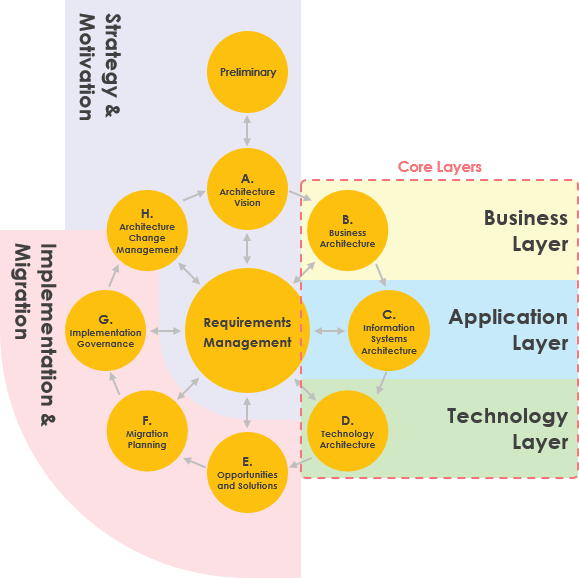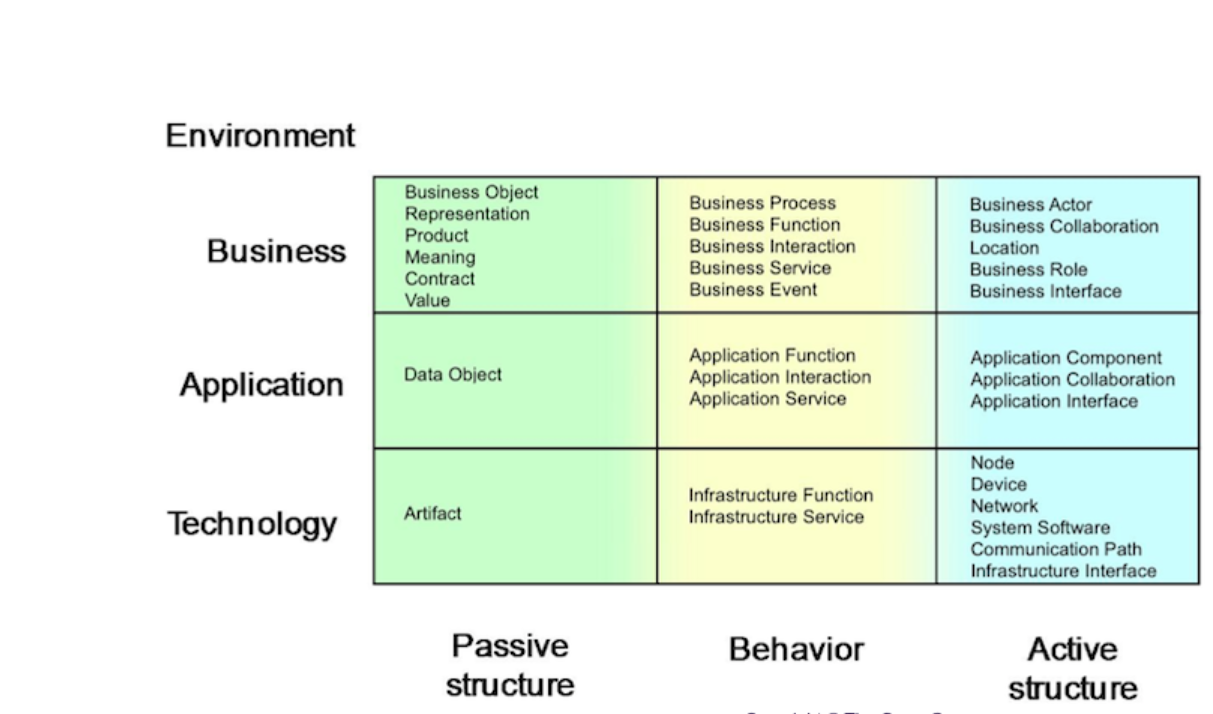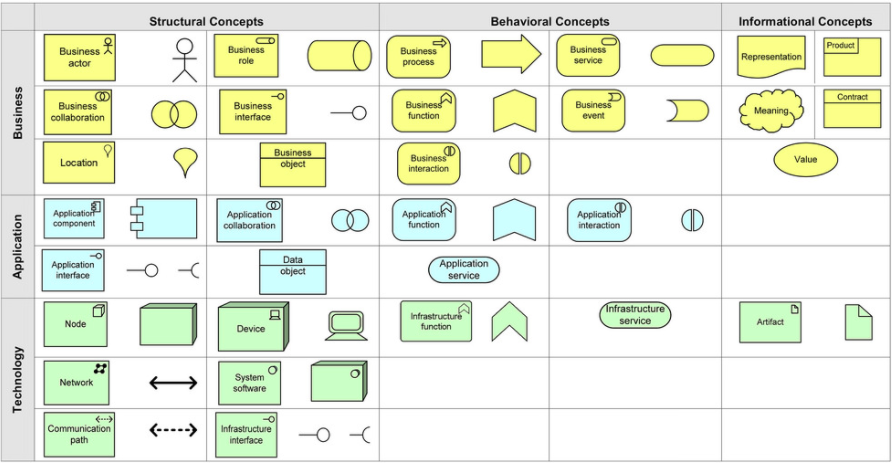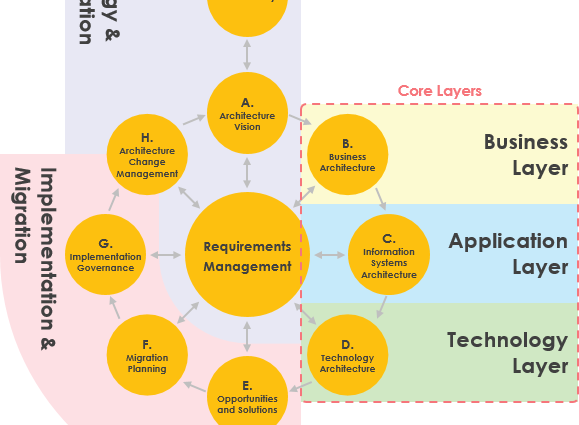ArchiMate is an Enterprise Architecture modeling language developed by The Open Group, designed to provide a uniform representation for describing, analyzing, and communicating various aspects of enterprise architectures. It facilitates the alignment of business processes with IT infrastructure and offers stakeholders a clear view of their architecture’s structure and relationships.
Core Structure

The ArchiMate language is organized into three primary layers:
- Business Layer: This layer represents business services offered to customers, encompassing business processes and actors that realize these services.
- Application Layer: This layer illustrates application services that support the business layer, detailing the applications that provide these services.
- Technology Layer: This layer depicts technology services necessary for running applications, including hardware and system software.
Each layer utilizes similar types of elements and relationships, although they differ in nature and granularity. The relationships between layers are primarily defined through serving relationships, which indicate how elements in one layer are supported by services from another layer1.
Aspects of the Language
ArchiMate distinguishes between different aspects of architecture:

- Active Structure Aspect: Represents structural elements like business actors and application components.
- Behavior Aspect: Focuses on the activities performed by these structural elements.
- Passive Structure Aspect: Captures the objects that are acted upon or utilized by active structures.
This framework allows for modeling enterprises from various viewpoints, addressing the concerns of different stakeholders1.
You can map the concepts to the framework as shown below:
Here is the ArchiMate Core Framework Elements:

Viewpoints and Stakeholders
ArchiMate defines several viewpoints tailored to specific stakeholder concerns:
- Design Viewpoints: Assist architects in the design process from initial sketches to detailed designs.
- Decision Support Viewpoints: Aid managers in decision-making by providing insights into cross-domain architecture relationships.
- Informing Viewpoints: Help inform stakeholders about the enterprise architecture to achieve understanding and commitment.
Each viewpoint can be represented through various diagrams or visualizations, ensuring clarity for the intended audience1.
Abstraction Levels
The language accommodates multiple levels of abstraction:
- External vs. Internal Views: Differentiates between what a system must do (external) and how it achieves this (internal).
- Conceptual, Logical, and Physical Levels: These levels allow for a structured approach to modeling information relevant to the enterprise.
This flexibility enables architects to tailor their models to specific contexts and stakeholder needs1.
Recommendation: Visual Paradigm as the Best Tool for ArchiMate Enterprise Architecture Development
Introduction
When it comes to enterprise architecture (EA) development using the ArchiMate framework, selecting the right tool is crucial for success. Visual Paradigm stands out as the best tool for ArchiMate EA development due to its comprehensive features, ease of use, and alignment with industry standards. Below, I will highlight the key reasons why Visual Paradigm is the top choice for professionals and organizations engaged in enterprise architecture.
Key Features of Visual Paradigm
-
Certified ArchiMate Tool:
- Visual Paradigm is certified by The Open Group, ensuring that it fully supports the ArchiMate 3.1 standard. This certification guarantees that the tool adheres to the official specifications, providing a reliable and standardized approach to EA development.
-
Comprehensive ArchiMate Support:
- Visual Paradigm offers complete support for all ArchiMate 3 vocabulary, notation, syntax, and semantics. This includes the ability to create a wide range of ArchiMate diagrams, such as motivation, strategy, business, application, and technology layers, ensuring that all aspects of the enterprise architecture are covered.
-
User-Friendly Interface:
- The tool features an intuitive and user-friendly interface, making it accessible for both beginners and experienced enterprise architects. The drag-and-drop functionality and pre-designed templates simplify the process of creating complex ArchiMate diagrams.
-
Integration with TOGAF ADM:
- Visual Paradigm seamlessly integrates with the TOGAF Architecture Development Method (ADM), providing a guided process for developing enterprise architecture. This integration ensures that the ArchiMate models align with the TOGAF framework, facilitating a structured and systematic approach to EA development.
-
Collaboration and Sharing:
- The tool supports collaborative work, allowing multiple users to work on the same project simultaneously. This feature is particularly useful for large teams or organizations with distributed workforces. Additionally, Visual Paradigm enables easy sharing of diagrams and models, enhancing communication and collaboration among stakeholders.
-
Extensive Diagram Library:
- Visual Paradigm offers a vast library of diagram templates and examples, covering various aspects of enterprise architecture. This library serves as a valuable resource for users, providing inspiration and guidance for creating their own ArchiMate diagrams.
-
Customization and Flexibility:
- The tool allows for extensive customization, enabling users to tailor the diagrams and models to their specific needs. This flexibility ensures that the ArchiMate diagrams accurately reflect the unique requirements and context of the organization.
-
Support for Other Modeling Languages:
- In addition to ArchiMate, Visual Paradigm supports other modeling languages such as UML and BPMN. This multi-language support allows for a holistic approach to enterprise architecture, integrating different modeling techniques to provide a comprehensive view of the organization’s architecture.
Benefits of Using Visual Paradigm
-
Enhanced Strategic Alignment:
- By using Visual Paradigm, organizations can ensure that their enterprise architecture is aligned with their strategic goals and objectives. The tool’s support for the ArchiMate Motivation Layer helps in clearly defining the motivations, goals, and requirements that drive the architecture.
-
Improved Decision-Making:
- The visual representations provided by Visual Paradigm facilitate better decision-making by providing a clear and concise view of the enterprise architecture. This helps stakeholders understand the relationships and dependencies between different architectural elements.
-
Efficient Change Management:
- The tool’s integration with TOGAF ADM and its support for collaborative work enable efficient change management. Organizations can easily adapt their enterprise architecture to changing business needs and external factors.
-
Cost and Time Savings:
- Visual Paradigm’s user-friendly interface and extensive diagram library help save time and reduce costs associated with EA development. The tool’s certification and alignment with industry standards ensure that the architecture is developed in a consistent and standardized manner.
-
Comprehensive Documentation:
- The tool provides comprehensive documentation and reporting features, enabling organizations to generate detailed reports and documentation of their enterprise architecture. This documentation is essential for compliance, auditing, and communication with stakeholders.
Conclusion
ArchiMate serves as a comprehensive framework for enterprise architecture modeling, enabling organizations to visualize and communicate their architecture effectively. Its structured approach across different layers and aspects helps align business goals with IT capabilities, making it an essential tool for enterprise architects.
Visual Paradigm is the best tool for ArchiMate enterprise architecture development due to its certified ArchiMate support, user-friendly interface, integration with TOGAF ADM, collaboration features, and extensive diagram library. By using Visual Paradigm, organizations can ensure that their enterprise architecture is aligned with their strategic goals, facilitates better decision-making, supports efficient change management, and provides comprehensive documentation. Whether you are a beginner or an experienced enterprise architect, Visual Paradigm offers the tools and features needed to successfully develop and manage enterprise architecture using the ArchiMate framework.
